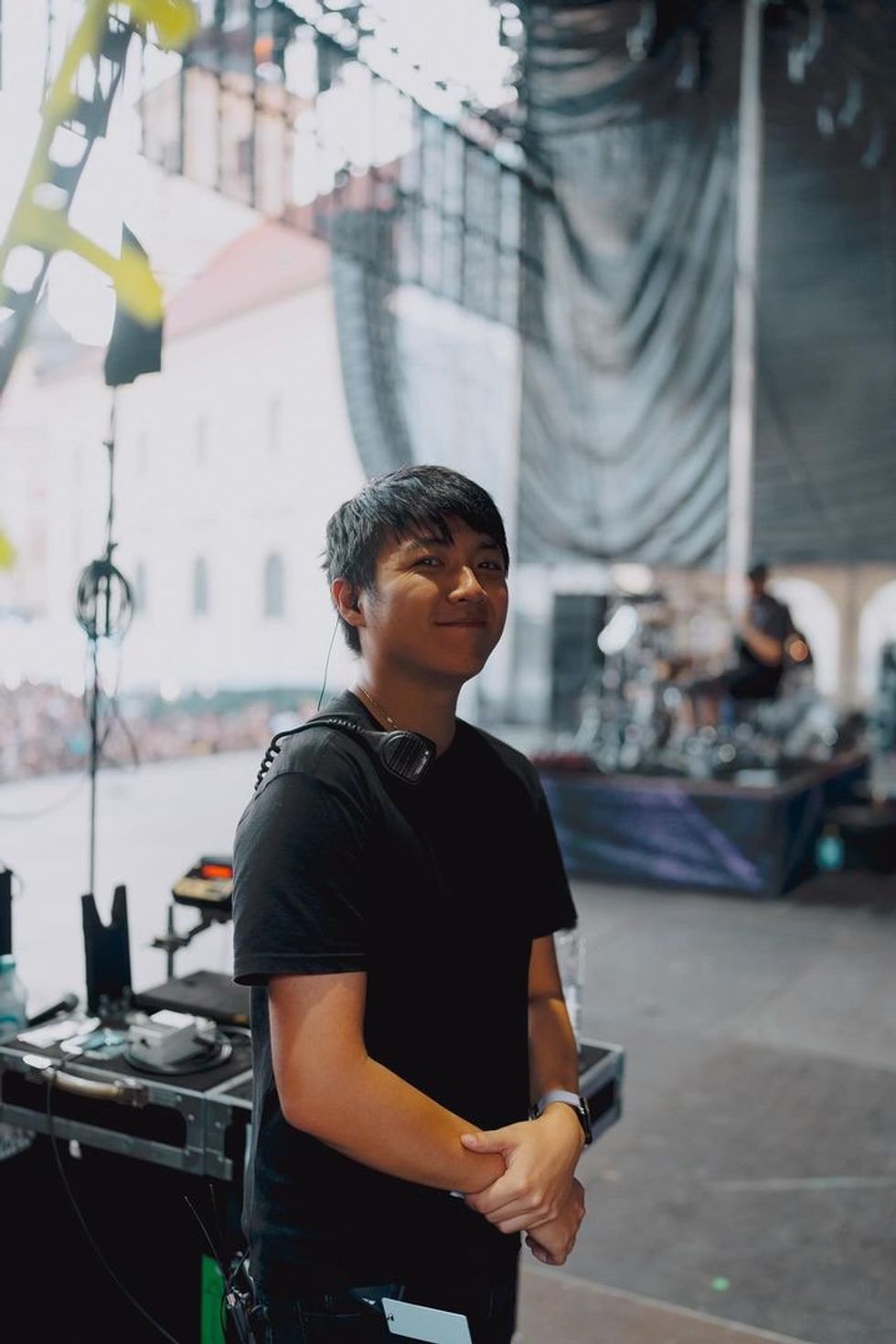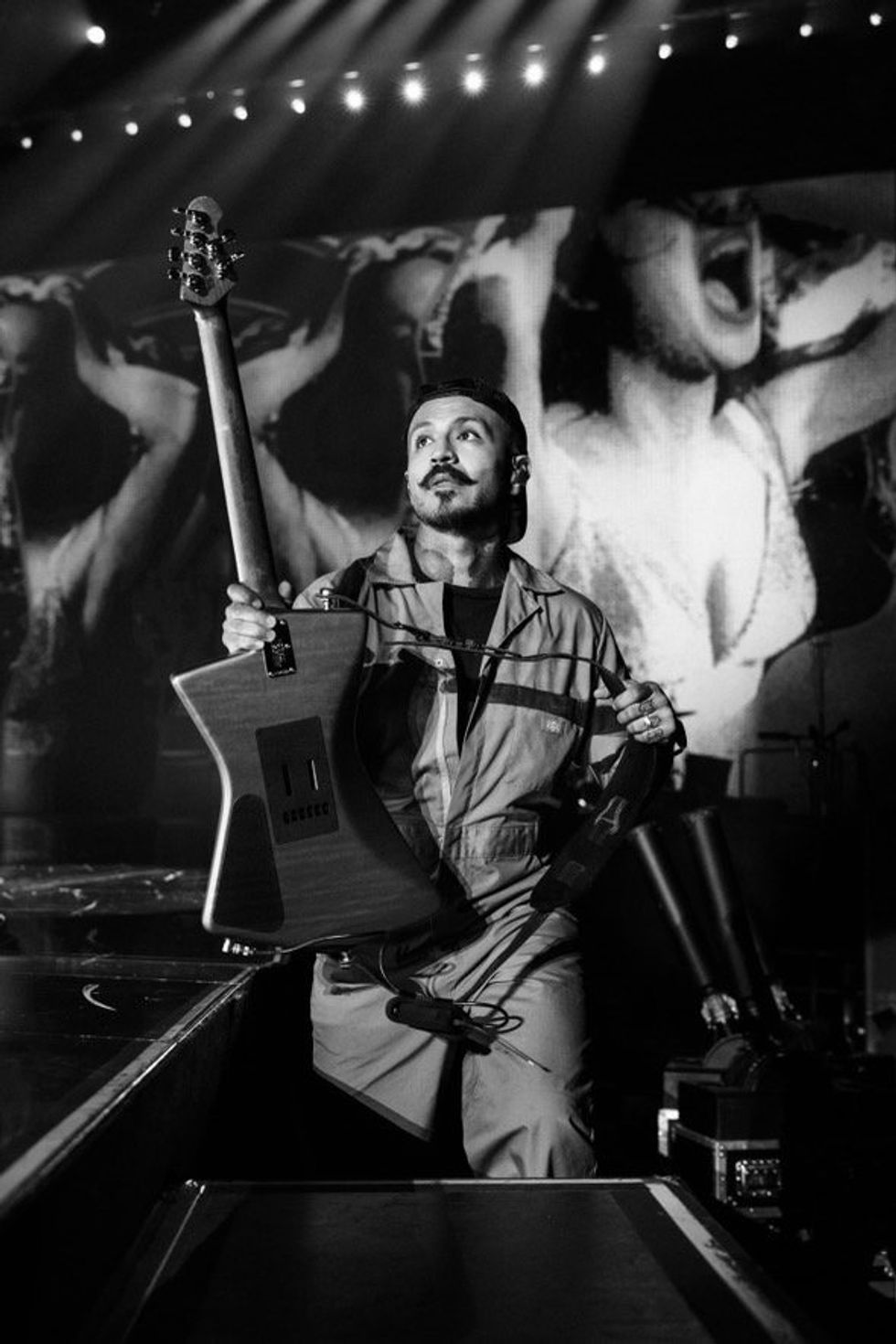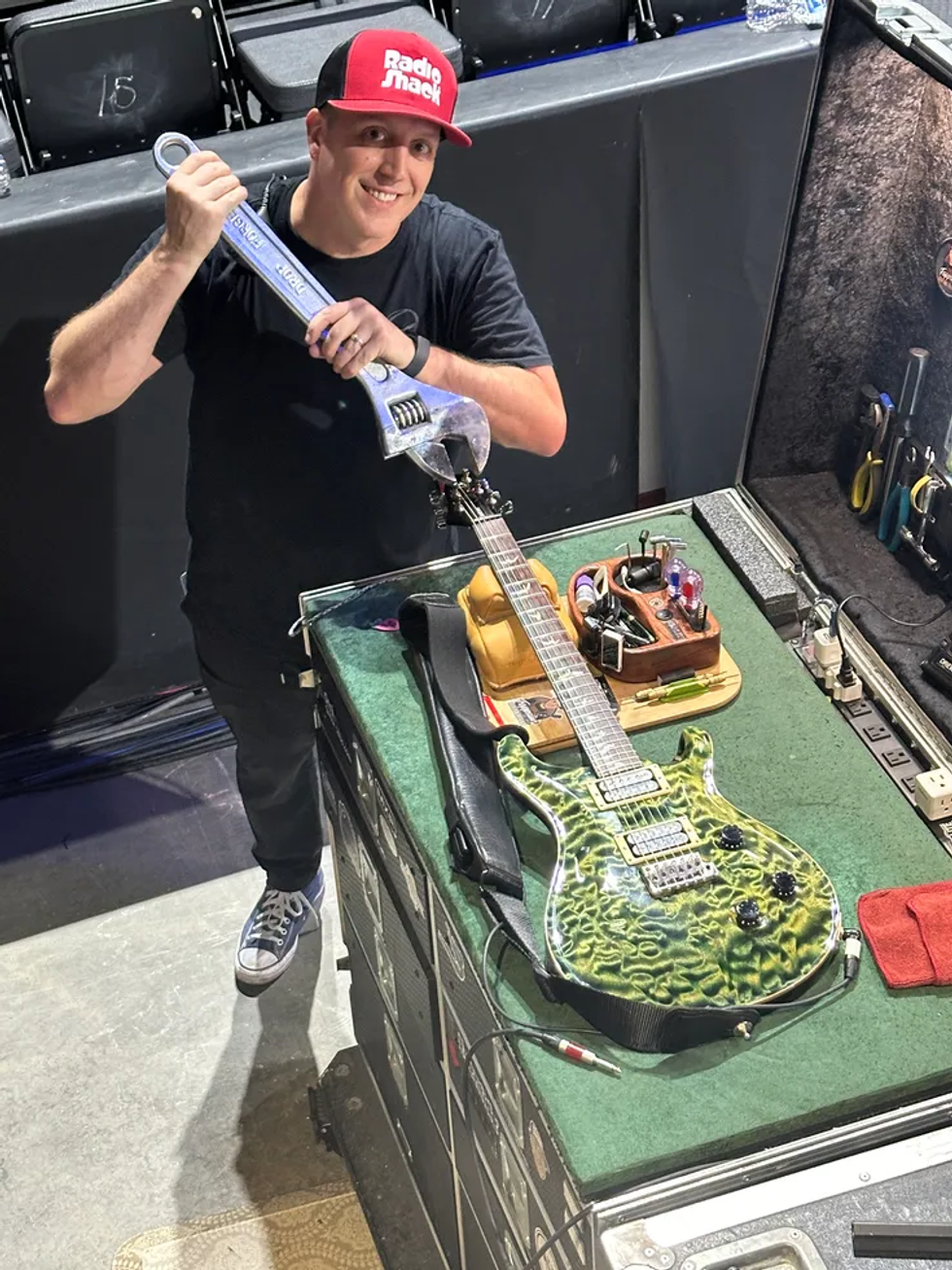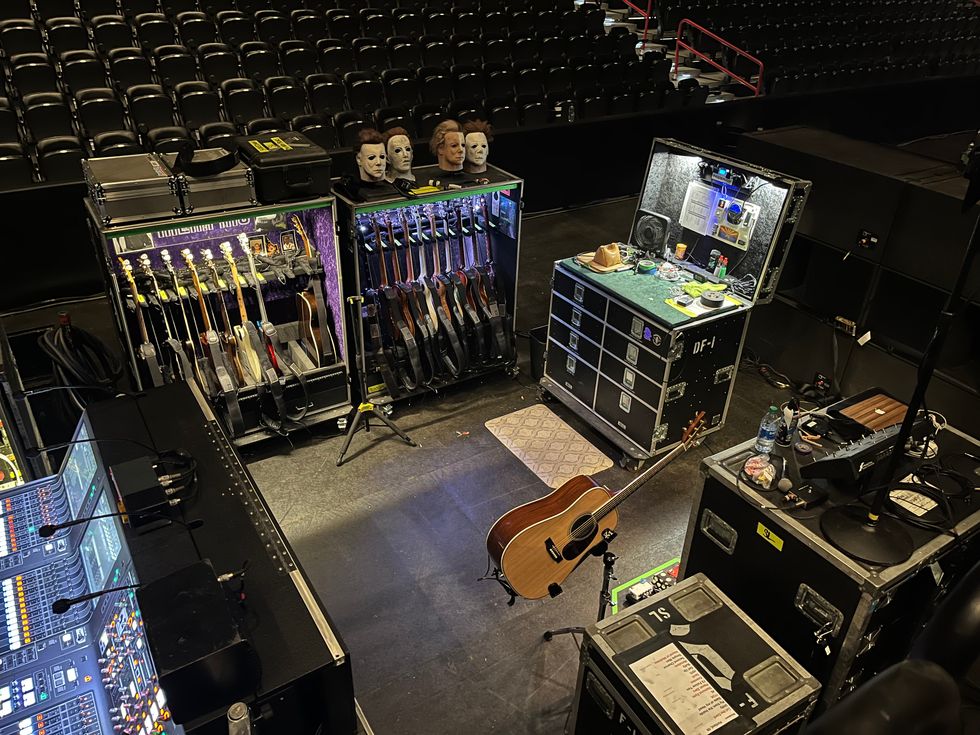I too am not a bit tamed, I too am untranslatable,
I sound my barbaric yawp over the roofs of the world.
—Walt Whitman, from the poem, “Song of Myself,” published in the collection Leaves of Grass.
A strained, hoarse cry—or “yawp,” for those guitarists who spaced out during SAT prep—provides an appropriate nom de plume for the Yawpers, a band whose energy embodies that raucous ideal. They started as a power trio fronted by two electrified, overdriven acoustic guitars, and then graduated to solidbodies as their music evolved, although they’ve never added a bassist. But despite that limited instrumentation, yawping—as in a “barbaric yawp over the roofs of the world”—seems the best way to describe the music they make. And yes, their name is a nod to the Walt Whitman poem.
The Yawpers played their first gigs in Boulder, Colorado, as an acoustic duo in 2011, but soon added a drummer and got a lot louder, fusing roots Americana with punk energy, psych, and blues. The group’s core is guitarist Jesse Parmet and vocalist/guitarist Nate Cook. The drum chair has changed a few times, and Alex Koshak is their most recent addition. Cook’s primary role is lead singer—he sounds like a cross between Elvis and Bon Scott—and his guitar parts are primarily supportive. Parmet fills in the rest and adds tonal color, beefy mids, and covers for the band not having a bassist.
Parmet does this via his varied and idiosyncratic rig. He uses three amplifiers and five different boxes to split his signal. One line runs to an Ampeg SVT to cover the low end; another goes to a ’70s-era Fender Twin, which he uses for his wet, effected signal; and another is split into both channels of a Matchless SC-30. “I do a lot of tap dancing,” he says. “Which is key to what we do, just being a three-piece and trying to get the dynamics right and get the arrangements to move.”
Hear the title track from the Yawpers’ latest album, Human Question.
Human Question is the band’s third full-length release on Chicago’s Bloodshot Records, and their fourth overall. They tracked it at Steve Albini’s Electrical Audio (see accompanying sidebar) and Alex Hall engineered and mixed the sessions. The album shows off the band’s breadth, from barnburners like the first two tracks, “Child of Mercy” and “Dancing on My Knees,” to more trippy, introspective numbers, like the title track and “Carry Me.” It stays true to their roots as well, which draw from rockabilly, Delta blues, ’80s-era hardcore, classic rock, and whatever they happen to be listening to.
“When the Yawpers started, I was listening to John Fahey and more fingerstyle stuff, plus Mississippi blues like R.L. Burnside and Bukka White,” Parmet says. “For the Boy in a Well album, our rockabilly influences were people like Elvis, Buddy Holly, and Reverend Horton Heat. This last record was more garage-rock influenced. I was listening to a lot of Link Wray—Captain Beefheart was also a big influence—and Thee Oh Sees.” We caught up with Parmet to discuss making heavy music on acoustics, his unique rig, different tunings, his insanely heavy guitar strings, and how they wrote and recorded Human Question.
The Yawpers started as an acoustic duo and then morphed into what you do now. Is that right?
That is true. Nate and I—Nate is the vocalist—had a group prior to this that had just disbanded. We were collecting ourselves, trying to do something stripped down, not so complicated, and it quickly started to become more of a real band once we added a drummer. For a while, we just had the acoustic guitars. I would run mine through amplifiers and overdrive pedals and gradually started incorporating electric guitars. Now it seems the acoustics are not used very often—mostly just for the older stuff.
How early in the band’s evolution did you start using pedals?
If I was going to play lead guitar, I needed some kind of boost. I had a Tube Screamer—that’s what I used for a while—and then I got the idea to add a second amplifier. I just had a Fender Twin Reverb—I still do—and I also had a Matchless SC-30. I figured out a way to split the signal, used that to fill things out, and had a boost option that gave me a couple of different dynamic possibilities to get louder. And then to get even louder from there.
When did you start using electrics?
For the Boy in a Well album that came out in 2017, I think I played all electric guitar on that. It felt like we had exhausted the possibilities of the acoustics, which is really cool for more of the slide stuff, which I don’t do as much of anymore. But we wanted more of an old-school rock ’n’ roll, rockabilly sound on that record. It was fun getting to try something different.
It seems like you lean more toward pawnshop electrics, as opposed to expensive, high-end gear. You’ve got that black-and-white Danelectro that looks like the Jimmy Page “Kashmir” guitar.
Yeah, just whatever I have laying around. For the last record, Boy in a Well, I did buy a ’64 Gretsch Anniversary. That was after I had broken the headstock on my 335. I had a session that day, and I went to the Chicago Music Exchange and saw that guitar there. It looked amazing and sounded amazing. I used that on the Boy in a Well record for most of the songs. I’ve also had a reissue Danelectro, which felt really cool but never really sounded that great, to be honest. But we recently got a new drummer, and he has a ’59 Danelectro, which is maybe the one you’ve seen me playing. That guitar sounded so much better and I ended up using it on the majority of this new record.
How do you set up your acoustics for playing heavier music?
I use [D’Addario] Resophonic strings, which are made for resonator guitars with higher action and to be played with the slide. They are heavier strings: The high string is a .016 and the low string—which works well for open tunings—is a .056. I use their Flat Top sets as well, which have a little less of that string noise when you’re playing slide guitar.
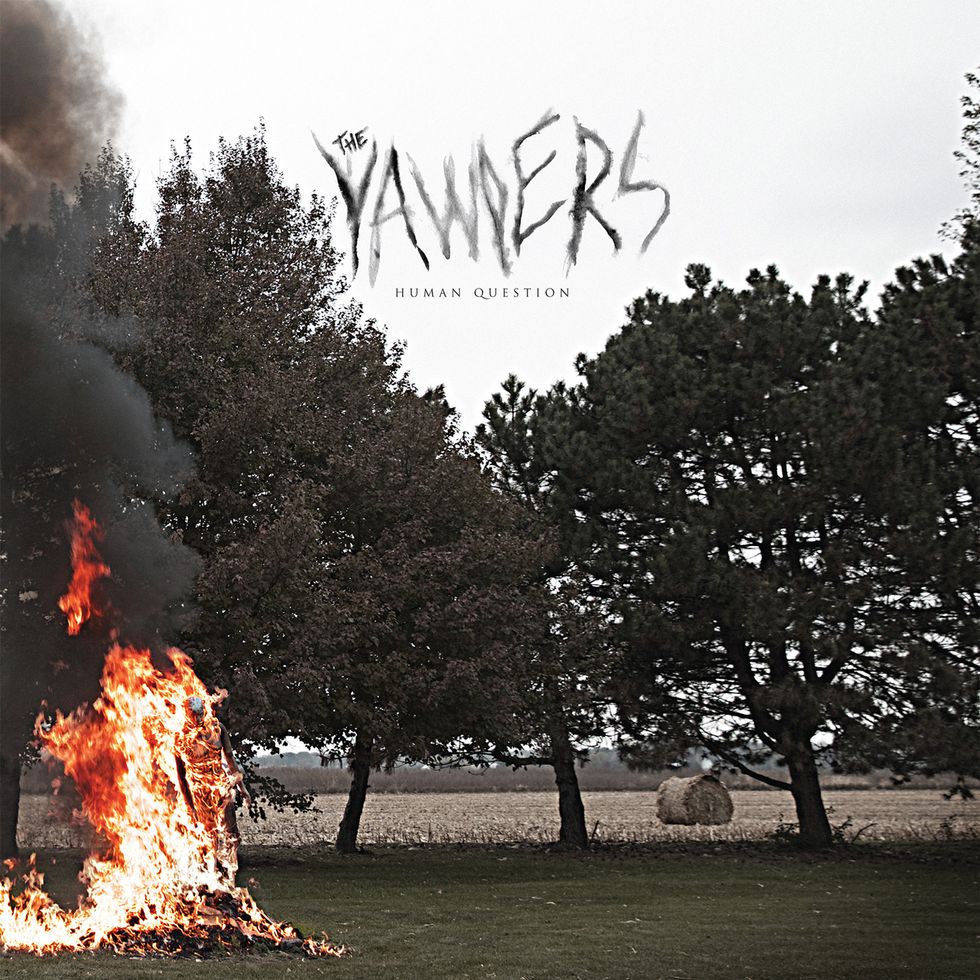
The Yawpers take their name from a poem in Walt Whitman’s Leaves of Grass.
How do you keep your acoustics from feeding back at higher volumes?
My guitar is very heavy because it is filled with all sorts of stuff to help with the feedback. Nothing professional, just my old clothing—socks, t-shirts, and underwear. That helps quite a bit. Some nights it gets away from me more than others depending on the room. But it works really well to play at high volumes. The other important part of the acoustic setup is the pickup I’m using. It is a magnetic pickup that’s designed for that sort of thing. It’s made by Sunrise and it works really well at higher volumes.
What are some tunings you use?
For the acoustics, open D [D–A–D–F#–A–D]. And open G [D–G–D–G–B–D] on one of my electrics, the Strat. But I tune down a half-step, so it’s open C# on acoustic and open F# on the electric. For this last record, I now have an open-C tuning that I use for a few songs, which is the same thing, just a step lower.
Your open-C tuning is open D, but a whole-step down?
Exactly. But for most of the album I’m using a bizarre tuning, which was my attempt to do something closer to standard tuning. I can get those barre chords in there and get more of a classic rock sound, if you will, while still having the low notes in there, because we don’t have a bass player, so I always have to be mindful of that.
Can you detail that tuning?
I have a low Bb, and then from there the inside four strings are similar to standard tuning, except they’re up a half-step, and I lower the 1st string a half-step from standard [Bb-Bb-Eb-Ab-C-Eb]. My initial thought was that if I wanted to play an A chord, it’s like an A power chord, but then the lowest string is the low octave of the A, instead of an E. And that would allow me to do barre chords—A-style power chords throughout with that low octave in there. I wasn’t able to get that guitar to work tuned all the way down to an A, so that’s why I went to a Bb as my bottom note. There are also some variations on the album based on that tuning.
When do you use a capo? Is that just to make the song work with the vocal range?
Yes. I’m constantly readjusting the tunings with a capo to get my guitar into whatever key the song is in. We have to take that into account, otherwise everything would be in the same key.
When you tour, do you travel with a number of different guitars?
Yeah, it’s not fun. I’ve got five guitars onstage right now. That goes down a little when I do Europe because it gets expensive to bring that many guitars.
Parmet cranks his acoustic through electric guitar amps, which forces him to take an unconventional approach to keep it from howling onstage. “My guitar is very heavy because it is filled with all sorts of stuff to help with the feedback,” he says. “Nothing professional, just my old clothing—socks, t-shirts, and underwear.” Photo by Anthony Nguyen
Do some pedals lend themselves better to acoustic guitars than others?
As far as overdrive, I used the Tube Screamer for a while, and I’ve tried a few other overdrive pedals. I found that the one I like best with the acoustic is the Boss Blues Driver. It adds that crunch to it but doesn’t take away too much from the character of the guitar.
Do you still have that in your pedalboard now?
Yes, and I use that as a boost for the electric as well. We were at Electrical Audio in Chicago for the last record—that’s Steve Albini’s recording complex, which is amazing. They have all sorts of great gear, and they have a really cool pedal selection. I ended up needing a couple of those pedals that I used for recording. They especially have a lot of EarthQuaker Devices, and I picked up a Park Fuzz Sound, which is an obnoxiously loud, noisy fuzz pedal. We use it for some of the extreme moments. I also got something called a Tentacle, which is a bizarre sounding pedal. It sort of gives you an octave. It’s not even clear to me what octave, if it’s going higher or lower. It’s not that extreme in terms of the octave effect—just a hint of it to my ears—and it also has a bit of a dying battery sound and a little bit of brightness. That in conjunction with the overdrive pedal adds some real crazy tones.
You also have a lot of switching devices.
My pedalboard is complicated, not because I have a lot of effects but because of my signal flow. I’m running two different guitar amplifiers, plus splitting out to a bass amp, plus I’m using a bunch of different guitars. I have one pedal on the front end that allows me to switch between three guitars. I have five, so I still have to unplug in the middle of the set. Then I have to split the signal from there out to the three different amplifiers. The bass chain has a boost going through it, and a mute pedal, and then each chain has a different flow. The Fender Twin is most of the overdrive and all of the effects. The Matchless is set dry: one splitter going into the clean channel and one going into its dirty channel.
Do you run both channels at the same time?
Yeah, I’m able to use the natural boost on the Matchless, which sounds great. I’m not quite able to get that sound from a pedal. I do a lot of tap dancing, which is key to what we do, just being a three-piece and trying to get the dynamics right and get the arrangements to move.
Do you use an octave effect for the bass or does the bottom end just come from the lower tuning?
I’ve never used octave effects. I tried it a couple of times, but it sounded kind of artificial to me. I run it straight to the bass amp. I take out all the highs from the bass split and boost the lows, and I also take out the mids and hope for the best. If you just plug your guitar into a bass amp, it doesn’t sound very good, but if you’re able to filter out those higher notes and let the low notes come through, it adds a lot.
Does your drummer do a lot to compensate for not having a bass as well?
We’ve always had to be conscious of that and the drummer has a pretty demanding job because of it. When we’re working out songs, we’re always trying to figure out cool drum parts and interesting ways to approach the music. One thing is to rely more on the floor tom, but every song is different. For me on guitar, a lot of times I’ll think of it like those old Delta blues guitar players, where you’re doing the bass line with your thumb and the rhythm with your fingers. We have all these little tricks we use, but every song is different and we try not to repeat ourselves too much.
So you also use a number of different picking and fingerpicking techniques?
I use a flatpick, and I use my fingers for some songs as well. When we were first starting out, I had been more into fingerstyle, like John Fahey, and trying to figure out how to do that. I experimented with a few things, like metal picks on my fingers—because I am always breaking my nails—but none of that stuff worked out that well for me. Some songs are more a straight punk rock thing with a pick, or I’ll use my fingers and a pick at the same time, or I’ll use straight fingers where my thumb is doing an alternating bass line.
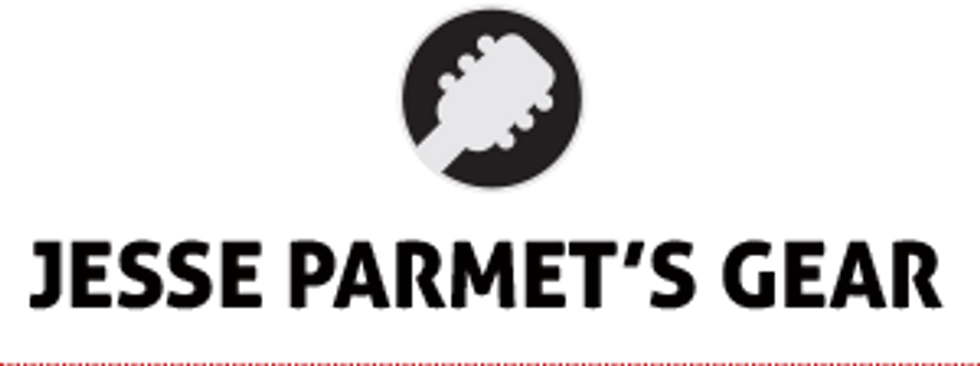
Guitars
’59 Danelectro
Gibson ES-335
Gretsch ’64 Anniversary Series
’90s Fender Fat Strat
’66 Fender Jazzmaster
'80s Yamaha dreadnought acoustic
Amps
’70s silverface Fender Twin
Matchless SC-30 combo
Ampeg SVT reissue bass amp
Effects
Vox wah
Lehle P-Split
Lehle Dual SGoS amp switcher
Lehle 3at1 SGoS instrument switcher
Little Lehle looper/switcher
Fulltone True-Path ABY-ST
EarthQuaker Devices Tentacle
EarthQuaker Devices Park Fuzz Sound
One Control Hooker`s Green Bassmachine
Boss Waza Craft DM-2W Delay
Boss BD-2 Blues Driver
Boss TU-3 Chromatic Tuner
MXR Dyna Comp
MXR Carbon Copy
Sunrise buffer box for the Sunrise magnetic pickup on the acoustic guitars
Strings and Picks
D’Addario EJ42 Resophonic strings (.016–.056)
D’Addario EFT13 Flat Top medium strings (.016–.056)
Mutant hybrid set assembled from whatever is available, gauged .016, .017, .026 (wound),
.032, .036, .062
Cool “Cat Tongue” .88 mm nylon flatpicks
Dunlop brass or copper slide
How tight are your arrangements? Do you jam and leave room to improvise or is it more structured and set?
It’s pretty structured, maybe more so than I would like. Things gradually evolve over time. Sometimes it’s conscious—we’ll have a rehearsal and we’ll try something—but other times, things occur naturally. We’ll start playing something onstage one night, it sounds good, and we’ll try it again the next night. But we’re certainly not too heavy on improvisation.
Some songs—“Savage Blue,” for example—have an epic arc and seem designed to take you to a new place.
“Savage Blue” is an example of one of our songs that leaves room for improv. That middle section in there, that is as close as we get to jamming. It’s just a big open section for whatever to happen.
At this point, can you intuit a lot of what Nate is going to do?
Absolutely. By now it’s pretty much second nature. We know each other’s sensibilities well and can feel where the other person is going to go, particularly when we’re arranging songs together. We have similar tastes.
How does the songwriting process work? Does it come out of jams? Do you show up with ideas?
We all show up with ideas. More and more, I spend time at home with my home studio—my bedroom basically—messing around with different ideas. Maybe trying drum loops or trying to figure out new, cool ways to approach things, combining different elements and different styles. Sometimes the structure comes together a little more, but usually not until I bring it into rehearsals. That’s when the arrangements really come together. Nate will bring in little pieces, too, and we’ll make those into songs. Sometimes Nate will bring in a more traditional song, something that’s more fleshed out. But these days we like that more experimental, raucous sound we get when all three of us are working stuff out together in the rehearsal space.
Do different tunings or different effects lend themselves to new ideas or force you to play the instrument differently?
Absolutely. I mean, I don’t want to say it’s a crutch, but it’s definitely something I lean on. Different tunings force you to play in different ways and come up with different parts. Open strings resonate in different ways than they would with standard tuning. Especially with our limited instrumentation, sometimes you need to find just the right part that’s going to cover all the bases.
What’s your setup like at home?
Nothing fancy. I just have a bare-bones Mbox Pro Tools setup. But lately, I’ve been able to get cool guitar tones at home. I live in an apartment and I don’t like to play through amplifiers there because I worry about the neighbors. It was always a problem getting decent guitar tones just going direct. So I got this speaker simulator made by a company called Palmer, and I’m stoked about it. You plug your guitar into your amplifier, disconnect the speaker connection, go from the output of the amplifier into the speaker simulator, and from there right into Pro Tools. You’re still hitting the amplifier and the tubes and all that without hearing it through the speaker. You get the quality of the amplifier, but basically you’re going direct.
Does the device have different speaker options?
They have it set up as British and American. They also have a tone selector with a deep setting and a brighter setting.
How do you and Nate divvy up your parts?I’m holding down the low end. He’s been playing through a Vox AC15 for the last couple of records. He’s got this bright, lo-fi ’50s tone, and I’ve got a beefier tone. But that’s just as far as tone. As far as arrangements, we intuitively know. When it comes time for the verse, I’ll make room for the vocals and when it comes time for the raging part, he’ll make room for me to do my thing. It’s not all that thought-out as far as how our guitar parts work together. It just happens.
Watch the Yawpers play a ripping “acoustic” set on Audiotree Live and see Jesse Parmet push his drop-tuned flattop into realms unimagined by its builders.
Formed in Denver, Colorado, the Yawpers have an unconventional lineup with no bassist. The trio consists of (from left) lead guitarist Jesse Parmet, drummer Alex Koshak—who joined the band in August 2018, just before they started tracking Human Question—and lead singer and rhythm guitarist, Nate Cook. Photo by Lex Quinn
Tracking at Electrical Audio
The Yawpers recorded their latest release, Human Question, in Chicago at legendary producer Steve Albini’s studio, Electrical Audio. During the process, the band moved between the studio’s two main rooms, studios A and B, which, according to Parmet, worked to their advantage. “We did three days in studio B, and that was basically all the live tracking,” he says. “Then we had seven days in studio A. The B room is really cool for live tracking. It’s got these 25-foot ceilings and a really nice character to the room. The A room is just an enormous, state-of-the-art space. You can set up different stations for overdubs and move from one to the other really quickly and easily. For us, 10 days was not a lot of time, but just being in that studio, everything ran so smoothly that we were able to be pretty efficient.”Part of the fun was rummaging through the studio’s closets, which were jam-packed with unusual, unique gear. “There were some cool instruments lying around, like this bizarre, 16-string guitar,” says Parmet. “I don’t know what note it’s tuned to exactly, but it was all high strings tuned in unison. [Albini made one of these guitars for Sonic Youth, liked it, and then also made one for himself.] They also had these all-metal [Veleno] guitars that had a really interesting resonant tone to them. I played one of those metal guitars, which I was told was used on Nirvana’s In Utero sessions [Albini produced the 1993 album]. I used that on ‘Can’t Wait,’ the second-to-last track on our record. He also had three or four vintage Big Muffs and all sorts of great effects pedals. You don’t want to go too crazy spending time messing around with tones, but it’s nice to have some options.”
But that said, being in a larger, well-equipped studio made a huge impact on the album’s overall sound. “I think the overdubs had a lot more character than some of our previous records, where we were just adding subtleties in the overdub process,” says Parmet. “These were more prominent in the mix.”


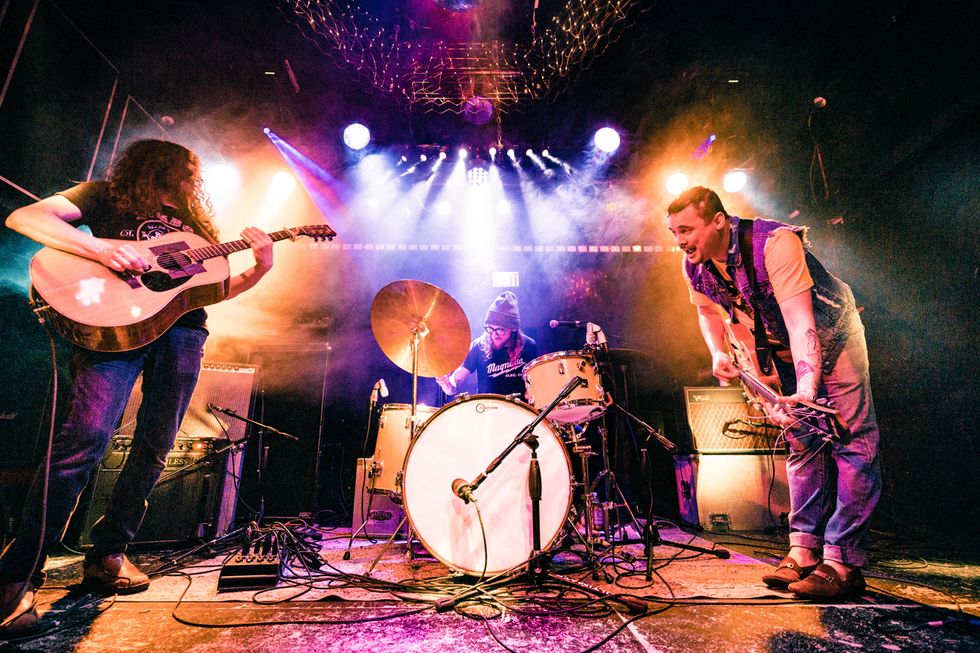
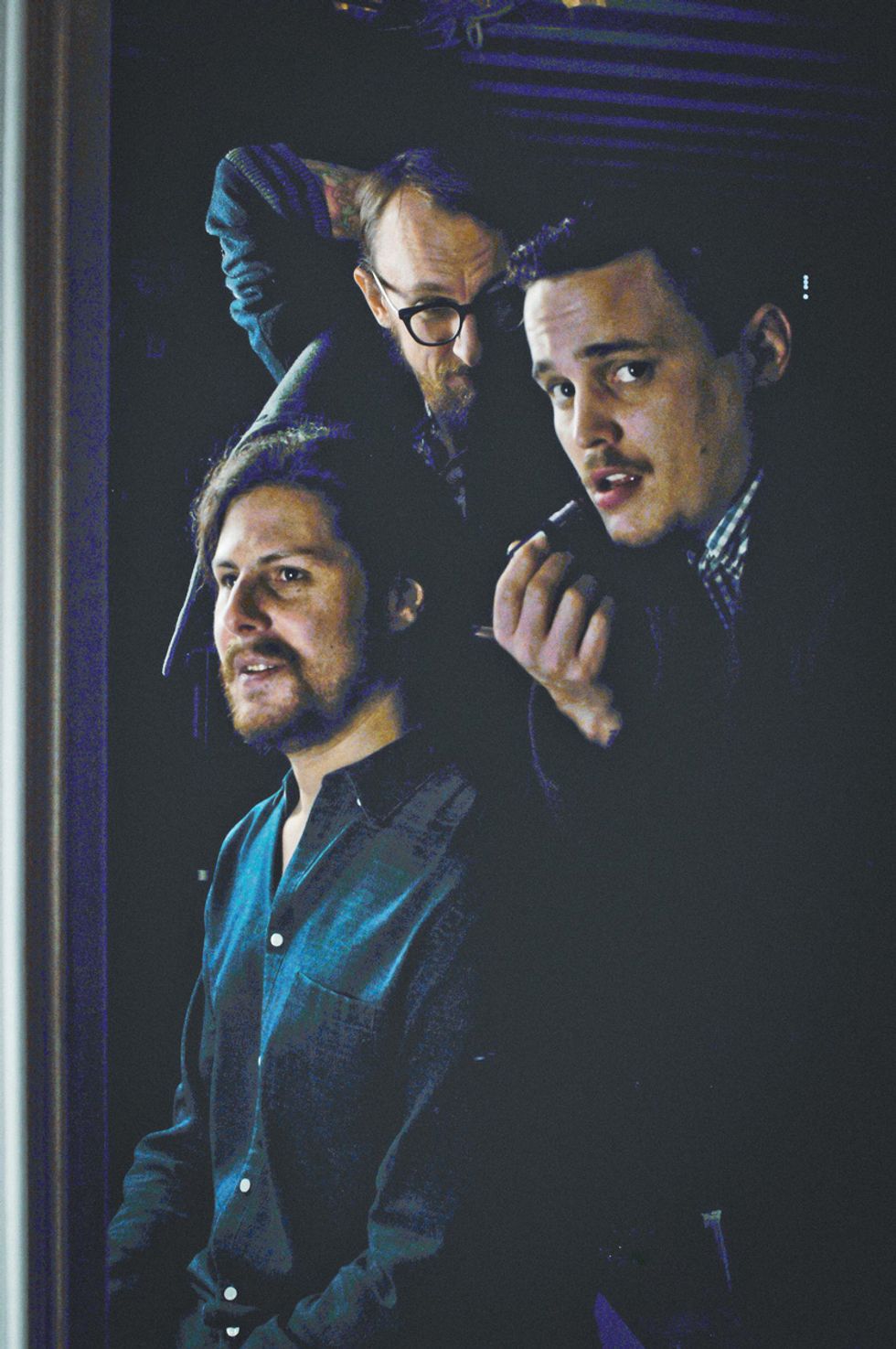




![Rig Rundown: AFI [2025]](https://www.premierguitar.com/media-library/youtube.jpg?id=62064741&width=1245&height=700&quality=70&coordinates=0%2C0%2C0%2C0)












 Shop Scott's Rig
Shop Scott's Rig


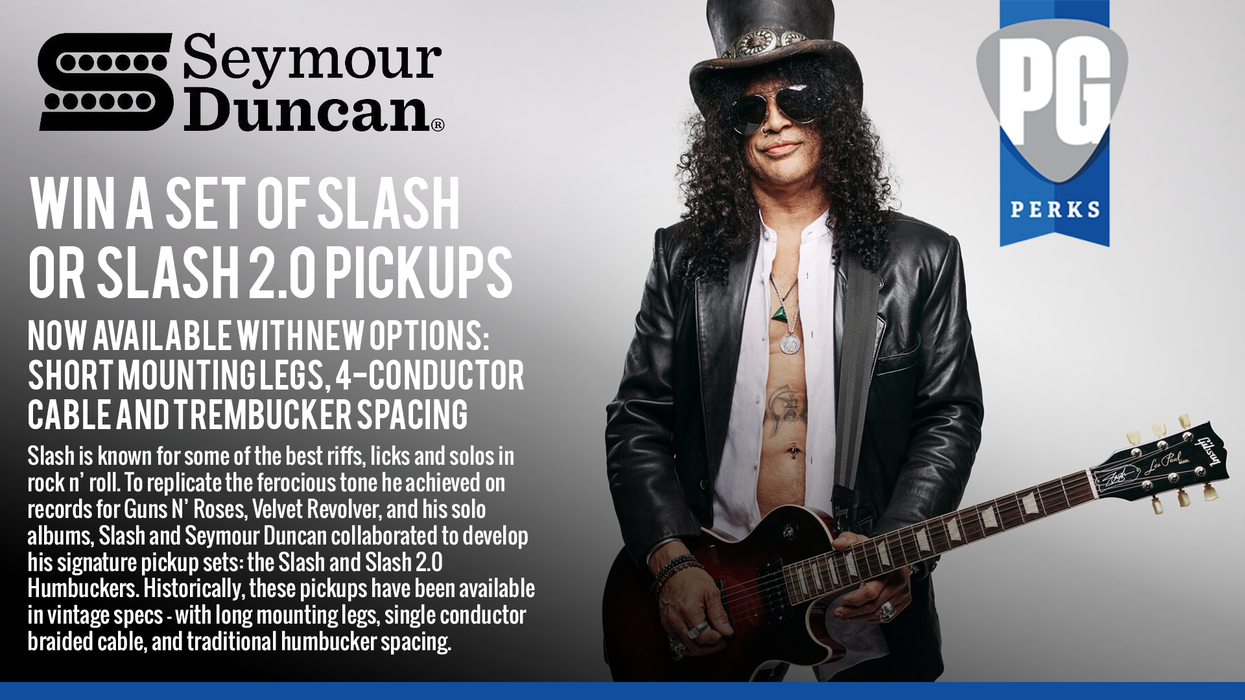










 Zach loves his Sovtek Mig 60 head, which he plays through a cab he built himself at a pipe-organ shop in Denver. Every glue joint is lined with thin leather for maximum air tightness, and it’s stocked with Celestion G12M Greenback speakers.
Zach loves his Sovtek Mig 60 head, which he plays through a cab he built himself at a pipe-organ shop in Denver. Every glue joint is lined with thin leather for maximum air tightness, and it’s stocked with Celestion G12M Greenback speakers.












![Devon Eisenbarger [Katy Perry] Rig Rundown](https://www.premierguitar.com/media-library/youtube.jpg?id=61774583&width=1245&height=700&quality=70&coordinates=0%2C0%2C0%2C0)







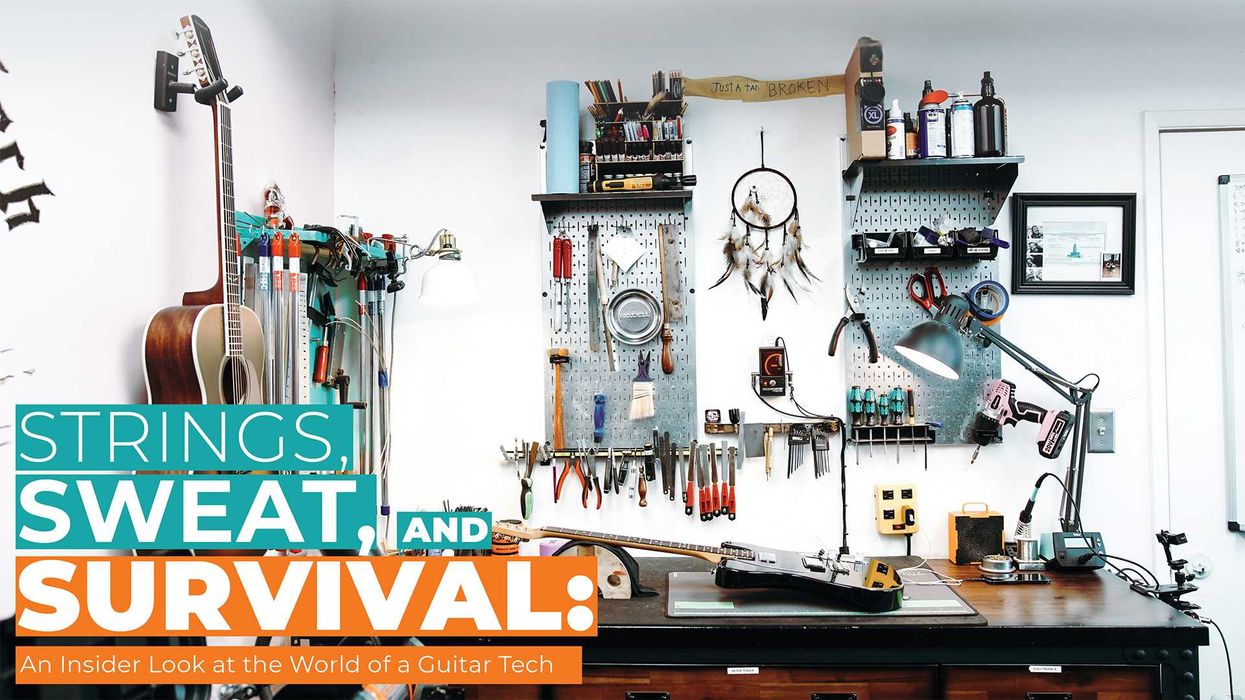
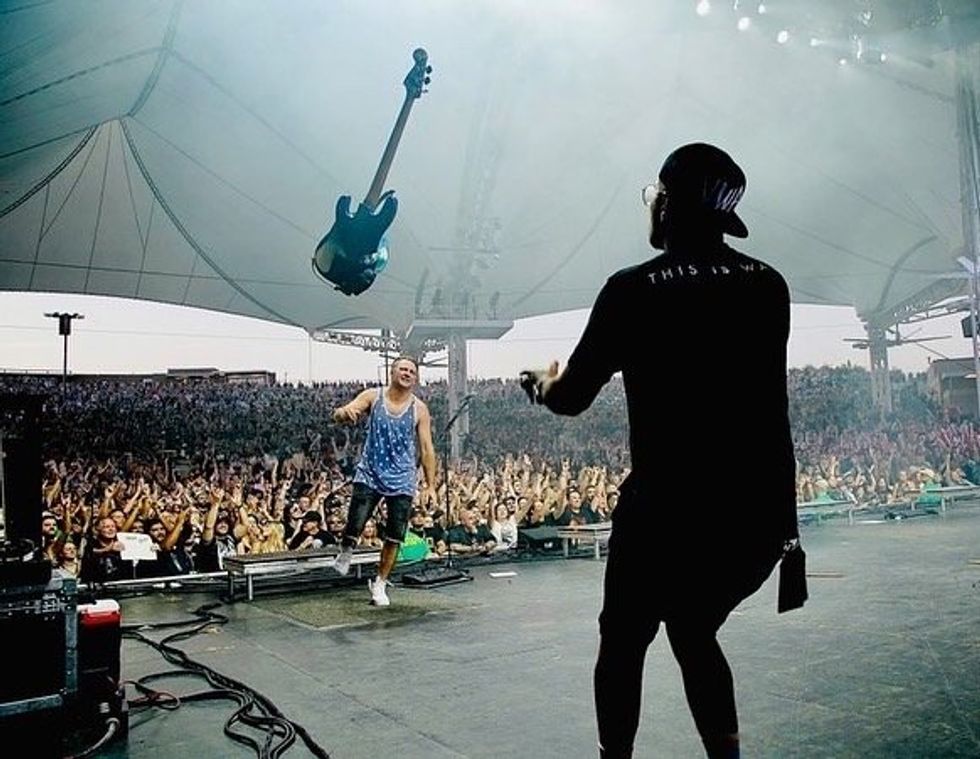 Luis Munoz makes the catch.
Luis Munoz makes the catch.